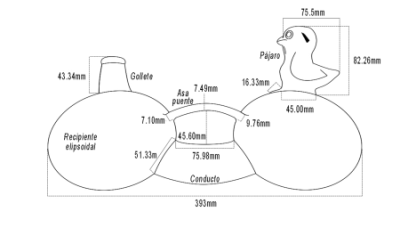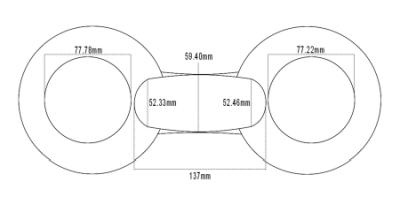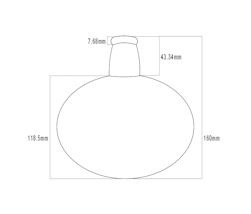
The original bottle on which this study is based is dark brown in colour, a result of reductive firing. Its walls range between 5.0mm to 8.0mm thick and it weighs 2110g (Figure 1).
Structurally, this bottle is formed by two symetrical ellipsoidal vessels. They are joined together by a curved cylindrical conduit that rises at the ends (conducto). Another element that fulfils the function of joining these vessels is the bridge handle (asa puente), built with a slightly curved rectangular slab. The ergonomic shape of the handle makes it easy to grip the object and facilitates the movement of the bottle when generating sound by means of a hydraulic system (Figure 9).

In the upper part of one of the containers the neck (gollete) is centred; this is cylindrical in shape with a slight decrease in diameter towards the upper part (Figure 10). Through this cylinder the liquid and/or the air enter, and is distributed through the conduit located in the lower part of the ellipsoids; elements that through blowing or tilting contribute to the sound production (Figure 11). In the neck there are traces of wear and loosening of the slip, mostly around the mouth of the vessel. This wear shows sound was possibly produced through frequent contact with the performer's mouth, a way of producing sound called direct blow; alternatively, the wear could result from introducing some liquid through the neck (Figure 12).


The ellipsoidal vessel at the other end has an ornithomorphic representation of a bird (pájaro) in front of the neck, with a short beak and tail (Figure 13). There are traces of iridescent paint in the form of stripes and dots on the vessel, a decorative effect characteristic of the Chorrera style as mentioned by Scott (1998). This type of painting has been studied and applied, in particular, by Klumpp (2017, 4), for whom iridescent painting is closely related, not only to the raw material used by the pre-Columbian artisan, but also to the technique used to paint. The effect is produced by using the index finger to apply an iron oxide-based paint (hematite) to the pottery body after it has been fired at low temperature.


On the surface of the bird, red engobe and evidence of ochre slip on the legs can be seen from the base of the neck, body and wings, a chromatic effect that also corresponds to the Chorrera style (Scott 1998). Due to the appearance of the colours and a small, almost rectangular geometric trace that is located under the bird, it can be determined that this figure was covered to prevent it from becoming contaminated by smoke at the time of reductive firing, in this way conserving the natural quality of colour of the engobe. This firing is necessary to create the effect of the iridescent paint, achieving a matte result in the bird and contrasting brightness in the ellipsoidal bodies.
In this structure of geometric components, this ornithomorphic representation is of remarkable relevance, not only because of its shape and size (70% of the height of the container that contains it) but because in it, inside the head, is hidden the whistle. The device, in this case, generates a sound similar to that of a real bird, so this becomes the most important element of the bottle.
Internet Archaeology is an open access journal based in the Department of Archaeology, University of York. Except where otherwise noted, content from this work may be used under the terms of the Creative Commons Attribution 3.0 (CC BY) Unported licence, which permits unrestricted use, distribution, and reproduction in any medium, provided that attribution to the author(s), the title of the work, the Internet Archaeology journal and the relevant URL/DOI are given.
Terms and Conditions | Legal Statements | Privacy Policy | Cookies Policy | Citing Internet Archaeology
Internet Archaeology content is preserved for the long term with the Archaeology Data Service. Help sustain and support open access publication by donating to our Open Access Archaeology Fund.